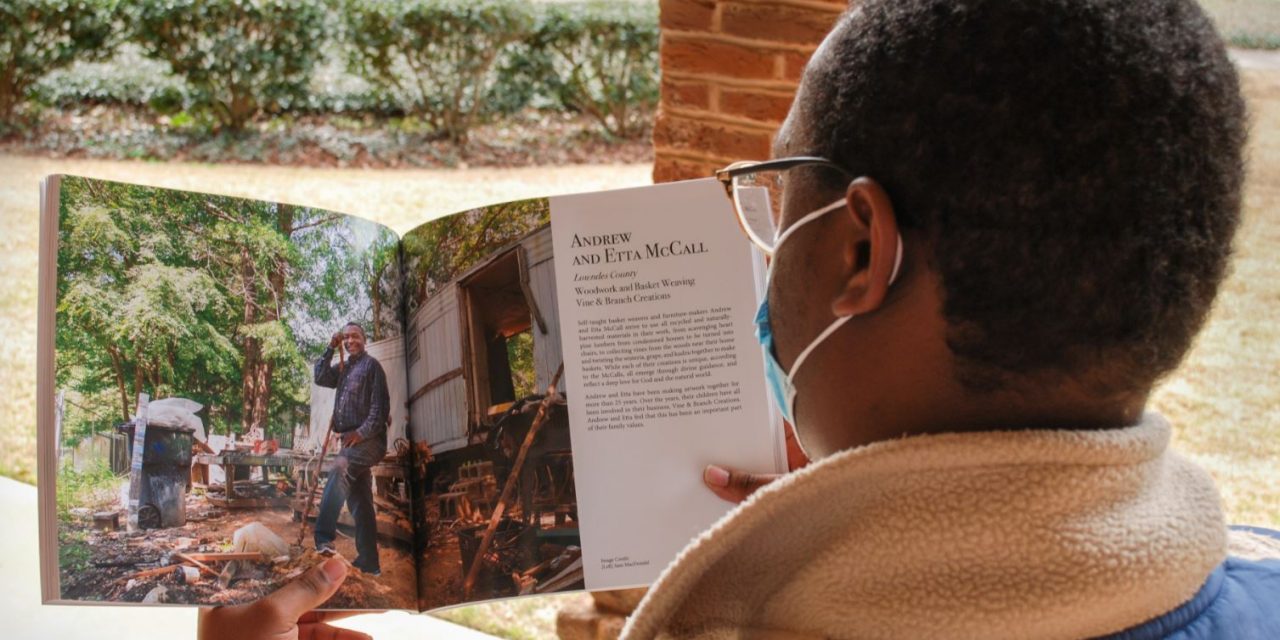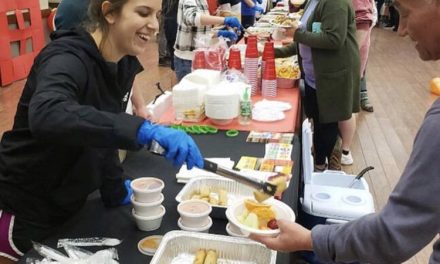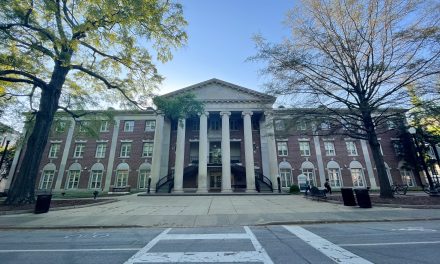Along the Black Belt, counties and homes rich with history, culture, artistry and exuberant kindness sit unnoticed by most. However, one cohort of University of Alabama (UA) students hoped to open the doors to those homes and bring the artists that resided within into the limelight with the “Black Belt Artist Project.”

Inside the Black Belt Artist Project book, created by the Department of Art and Art History at the University of Alabama, featuring black belt artist Deborah Carter, a quilter.
The project included a beautiful photography book funded by Canon Solutions America’s Future Author’s Project, a stellar exhibit in the Dinah Washington Cultural Arts Center and an intimate collection of video interviews.
Before the project became an ode to the artists of the Black Belt, it began as a simple idea Chris Jordan, a UA associate professor of photography and digital media, had in early 2018 for students to learn about photography while also working in the community.
In “a string of coincidences,” Jordan got in contact with Kristin Law, the art programs and marketing director of the Black Belt Treasurers Cultural Arts Center in Camden, Alabama, a non-profit organization that works to stimulate the economy of the Black Belt region.
Together Jordan and Law began to brainstorm ways the photographers could serve the greater Black Belt community and the artistic community.
“That conversation resulted in a realization that many of these artists are getting up in years, and there is a pressing need to document them,” Jordan said. “Preserve this very rich cultural history for prosperity before these stories are lost.”
The “Black Belt Artist Project” would photograph portraits of the artists in their homes while conducting video interviews of them telling their story to preserve those artists’ histories.
During the spring semester of 2019, Jordan and his eight students, Savannah Biggert, Arielle Gray, Jasmine James, Kayla Lawson, Holly Ray, Kassidy Stewart, Amber Quinn and Candace VonHoffman, loaded up their cars with equipment, excitement and intrigue for the Black Belt and began their first of four-weekend trips for the project in Wilcox County.
In a three-week summer interim course later on, another cohort of students, Sarah Cheshire, Sam McDonald, Kasandra Boor, Aleiah Briggs and Maddy O’Connor, built upon the others’ work and brought the project home with a trip to Monroe County.
Along the way, as they got to know the Black Belt artists through their stories and work, the cohort also expanded their knowledge of the region.
Jordan said he was familiar with portions of the history and culture of the Black Belt. Still, his understanding was “surface level” until they began to talk to the artists and get first-hand perspectives of what it was like to grow up in the region.
“I think a lot of folks, in general, don’t understand what a treasure [the Black Belt] truly is in terms of the range of talent in the area, the wisdom, the level of skill that these artists are working at,” he said. “It’s truly a remarkable region, and it’s so close by, so it was a real eye-opener.”

Black Belt Artist Project book, created by the Department of Art and Art History at the University of Alabama, featuring Alabama’s own black belt artists.
Sarah Cheshire, the project’s author and copy editor, agreed that this project was an eye-opener, especially as a former UA student.
“I think it was really cool and important getting to engage with the world outside of the University’s campus because I think people forget that we live in an area so rich in art and storytelling and folk tradition,” Cheshire said. “So, it was really cool being able to dig deep into the culture of the Black Belt and meet a lot of interesting, vibrant people.”
For Amber Quinn, a UA graduate student and one of the project’s photographers, the Black Belt was an area where she had little experience; however, after getting to know the people, hearing the honesty and vulnerability in their stories, she became appreciative of them.
They also gave her a new outlook on art.
Quinn said as a graduate student, she was used to thinking of art conceptually, but for the Black Belt artists, it wasn’t about exhibits or opportunities.
“They’re thinking about [art] as a necessity as something they can pass down to their loved ones and share within the community,” she said. “I just thought that was really beautiful because that’s what art is. That’s what it should be about.”
Cheshire said these trips also helped burst the college-induced Tuscaloosa bubble she had spent years in as a student.
“I feel like sometimes I get kind of stuck in the Tuscaloosa community and forget that the world exists outside of Tuscaloosa,” she said. “It was really informative getting to see the region that I’d been living in for four years through the lens of its artists and its storytellers.”

Article author, Jeffrey Kelly, exploring Black Belt Artist Project book, created by the Department of Art and Art History at the University of Alabama.
Along with learning the new region and meeting many amazing artists, the cohorts grew closer and created lasting memories with one another.
One memory that stood out the most to Jordan was staying with Andrew and Etta McCall, woodwork and basket weaving artists in Lowndes County.
Though the trip there was full of wrong directions and dead ends on dirt roads, McCall and his family warmly welcomed them into their home.
“Immediately when we got there, we felt at ease because Andrew was so warm to us and such a wise man, he endeavored to really share his life wisdom with the students,” Jordan said.
After they finished a heartwarming session, McCall circled the cohort up and sent them off with a heartfelt blessing wishing them safety on their journey and success on their project.
“I just remembered the birds chirping in the trees around us and the sun beaming down us during that moment,” Jordan said. “It was one of those indelible moments that will stick with me, and it hits you in the heart. I think many of the students would echo that sentiment of that being one of several high points.”
And out of those high points, the cohort not only created fond memories, but they also created fantastic work which debuted in Fall 2020.
“We had our conflicts as most groups do, but I feel like we definitely learned a lot from each other,” Cheshire said. “Then, at the end, me and Sam and Kasandra and Chris worked on compiling the book. I think that was kind of a collaborative process in itself because we were all bringing a lot of experience in it.”
The students from Jordan’s class and other UA students and faculty members worked attentively to make sure the book flowed together, showcased the artists in the best light and embodied the months of work everyone had put in.
Jordan said having this project serve such a wide number of people was a high point of his career, and people might not realize it, but it was a long process that pushed the students to do their best.
“We had a few meltdowns along the way, but everything is a growing opportunity, a learning experience, and I think that’s the beauty of having the classroom in that real-world dynamic,” he said. “It’s not sheltered there’s no safety net; you have to stand on your two feet and figure things out and in a way that has a spirit of understanding and a spirit of helping each other out.”
Quinn said the process of making the book was beautiful, but the finished product was inexplicable and so important.
“I just really appreciated that we got to do that for them because I also don’t know if they would have got to do that or if they would have had the resources to do those things on their own,” she said. “So being able to come together as a community, [Tuscaloosa and their community], bring the two ideas together and be able to have that kind of finalized product was different and it was necessary. I don’t know if they would have realized that had we not done the project.”
Though due to the pandemic, the course will not be happening this year, Jordan and his students encourage interested parties to be a part of the “Black Belt Artist Project” when its next round of tours begin.
“I think it’s a really good opportunity to get to know this place that we’re all living in together on a different level,” Cheshire said.
Although the photography books are not currently available, those interested in learning more about the “Black Belt Artist Project” can click this link or contact Chris Jordan at chris.jordan@ua.edu.






